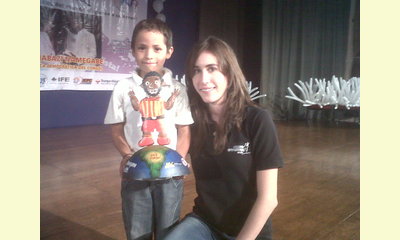|
|
Education on the rights of the children: a strategy for peace
un article par Vanessa Uriarte
On the International Peace Day, September 21th, the Closing Ceremony for the World Children's Prize was held, including many activities in Mexico.

click on photo to enlarge
The World Children's Prize is a worldwide movement founded in Sweden in 2000 for which every year children from all over the world choose a "hero" who works for the welfare and plight of children around the globe. This organization promotes and supports the rights of the child; it is the world’s largest annual educational program teaching children about their rights and democracy.
The votes from Mexico come through the Secretariat for Human Development of Jalisco. This institution contacts schools and non-governmental organizations that work with children in order to encourage them to participate with all their beneficiaries.
In the state of Jalisco, Mexico, 80,000 children from different schools and non-governmental organizations voted this year, including Children International Mexico where more than 2,500 children from urban marginalized communities from Jalisco participated .
At the same time, thousands of children in other places of the world voted as well. The winner in 2011 was Murhabazi Namegabe an advocate from the D.R. Congo who works rescuing child soldiers who had been taken by the guerrillas. Without violence and without fighting, he frees the children forced to be child soldiers or sex slaves and returns them back to their homes, in order for them to have a peaceful childhood.
|








|
DISCUSSION
Question(s) liée(s) à cet article:
How do we promote a human rights, peace based education?,
* * * * *
Commentaire le plus récent:
Question: what is the relation between peace and education?
http://cpnn-world.org/new/?p=4780
We teach the science of war on an even and equal basis with the 3Rs and we maintain it with more resources than any other school. Further, we have done this consistently for a couple of thousand years, long before education was institutionalized for all children. And we have never questioned the wisdom of teaching millions of civilians how to kill while never giving the same credence, or any for that matter, to the science of peace, the study of anti-war, of reconciliation. With this inured mindset leaders choose to fund boot camps and officer training colleges and by omission deprive youth of the better choice.
If we can teach war and violence with such commitment to suit the purposes of generals and the arms trade, where are the rest of us who have a greater need for peace and conciliation than anyone anywhere has for the killing fields? Why have civilians not demanded peace education long ago and why don't we have it now?

|
|









